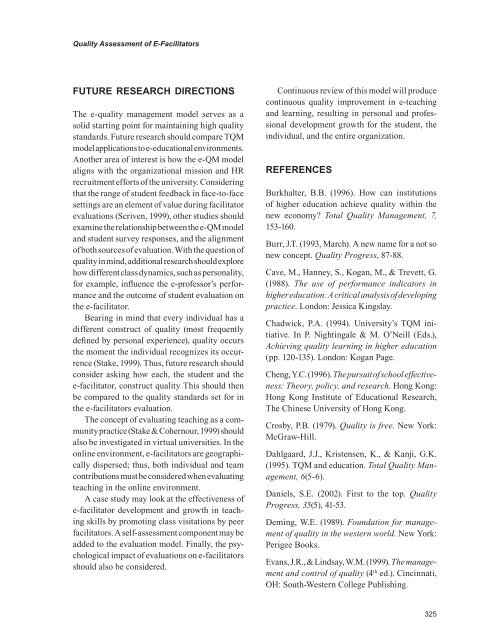Advances in E-learning-Experiences and Methodologies
You also want an ePaper? Increase the reach of your titles
YUMPU automatically turns print PDFs into web optimized ePapers that Google loves.
Quality Assessment of E-Facilitators<br />
Future reseArch dIrectIons<br />
The e-quality management model serves as a<br />
solid start<strong>in</strong>g po<strong>in</strong>t for ma<strong>in</strong>ta<strong>in</strong><strong>in</strong>g high quality<br />
st<strong>and</strong>ards. Future research should compare TQM<br />
model applications to e-educational environments.<br />
Another area of <strong>in</strong>terest is how the e-QM model<br />
aligns with the organizational mission <strong>and</strong> HR<br />
recruitment efforts of the university. Consider<strong>in</strong>g<br />
that the range of student feedback <strong>in</strong> face-to-face<br />
sett<strong>in</strong>gs are an element of value dur<strong>in</strong>g facilitator<br />
evaluations (Scriven, 1999), other studies should<br />
exam<strong>in</strong>e the relationship between the e-QM model<br />
<strong>and</strong> student survey responses, <strong>and</strong> the alignment<br />
of both sources of evaluation. With the question of<br />
quality <strong>in</strong> m<strong>in</strong>d, additional research should explore<br />
how different class dynamics, such as personality,<br />
for example, <strong>in</strong>fluence the e-professor’s performance<br />
<strong>and</strong> the outcome of student evaluation on<br />
the e-facilitator.<br />
Bear<strong>in</strong>g <strong>in</strong> m<strong>in</strong>d that every <strong>in</strong>dividual has a<br />
different construct of quality (most frequently<br />
def<strong>in</strong>ed by personal experience), quality occurs<br />
the moment the <strong>in</strong>dividual recognizes its occurrence<br />
(Stake, 1999). Thus, future research should<br />
consider ask<strong>in</strong>g how each, the student <strong>and</strong> the<br />
e-facilitator, construct quality This should then<br />
be compared to the quality st<strong>and</strong>ards set for <strong>in</strong><br />
the e-facilitators evaluation.<br />
The concept of evaluat<strong>in</strong>g teach<strong>in</strong>g as a community<br />
practice (Stake & Cohernour, 1999) should<br />
also be <strong>in</strong>vestigated <strong>in</strong> virtual universities. In the<br />
onl<strong>in</strong>e environment, e-facilitators are geographically<br />
dispersed; thus, both <strong>in</strong>dividual <strong>and</strong> team<br />
contributions must be considered when evaluat<strong>in</strong>g<br />
teach<strong>in</strong>g <strong>in</strong> the onl<strong>in</strong>e environment.<br />
A case study may look at the effectiveness of<br />
e-facilitator development <strong>and</strong> growth <strong>in</strong> teach<strong>in</strong>g<br />
skills by promot<strong>in</strong>g class visitations by peer<br />
facilitators. A self-assessment component may be<br />
added to the evaluation model. F<strong>in</strong>ally, the psychological<br />
impact of evaluations on e-facilitators<br />
should also be considered.<br />
Cont<strong>in</strong>uous review of this model will produce<br />
cont<strong>in</strong>uous quality improvement <strong>in</strong> e-teach<strong>in</strong>g<br />
<strong>and</strong> learn<strong>in</strong>g, result<strong>in</strong>g <strong>in</strong> personal <strong>and</strong> professional<br />
development growth for the student, the<br />
<strong>in</strong>dividual, <strong>and</strong> the entire organization.<br />
reFerences<br />
Burkhalter, B.B. (1996). How can <strong>in</strong>stitutions<br />
of higher education achieve quality with<strong>in</strong> the<br />
new economy? Total Quality Management, 7,<br />
153-160.<br />
Burr, J.T. (1993, March). A new name for a not so<br />
new concept. Quality Progress, 87-88.<br />
Cave, M., Hanney, S., Kogan, M., & Trevett, G.<br />
(1988). The use of performance <strong>in</strong>dicators <strong>in</strong><br />
higher education: A critical analysis of develop<strong>in</strong>g<br />
practice. London: Jessica K<strong>in</strong>gslay.<br />
Chadwick, P.A. (1994). University’s TQM <strong>in</strong>itiative.<br />
In P. Night<strong>in</strong>gale & M. O’Neill (Eds.),<br />
Achiev<strong>in</strong>g quality learn<strong>in</strong>g <strong>in</strong> higher education<br />
(pp. 120-135). London: Kogan Page.<br />
Cheng, Y.C. (1996). The pursuit of school effectiveness:<br />
Theory, policy, <strong>and</strong> research. Hong Kong:<br />
Hong Kong Institute of Educational Research,<br />
The Ch<strong>in</strong>ese University of Hong Kong.<br />
Crosby, P.B. (1979). Quality is free. New York:<br />
McGraw-Hill.<br />
Dahlgaard, J.J., Kristensen, K., & Kanji, G.K.<br />
(1995). TQM <strong>and</strong> education. Total Quality Management,<br />
6(5-6).<br />
Daniels, S.E. (2002). First to the top. Quality<br />
Progress, 35(5), 41-53.<br />
Dem<strong>in</strong>g, W.E. (1989). Foundation for management<br />
of quality <strong>in</strong> the western world. New York:<br />
Perigee Books.<br />
Evans, J.R., & L<strong>in</strong>dsay, W.M. (1999). The management<br />
<strong>and</strong> control of quality (4 th ed.). C<strong>in</strong>c<strong>in</strong>nati,<br />
OH: South-Western College Publish<strong>in</strong>g.


